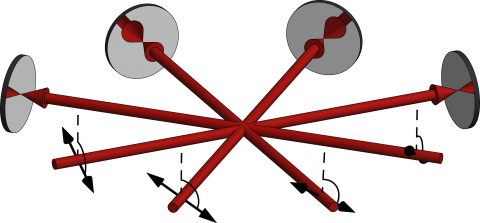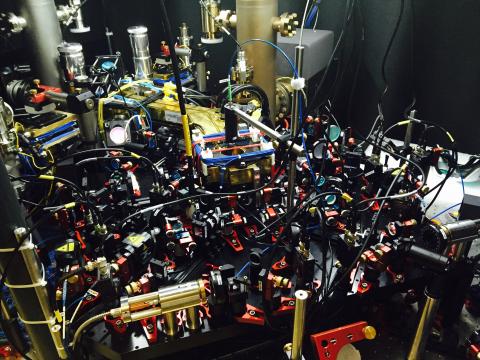Optical Quasicrystal
Ultracold atoms in optical lattices are used as versatile quantum simulators to shed light on a large variety of problems in many-body physics. In these experiments, atoms take the roles of electrons in solids, while the crystal structure is imposed externally using laser light.
In this project, whose first results have now been published as an Editor's suggestion in PRL, we have moved beyond traditional periodic lattices and have engineered an optical quasicrystal.
Quasicrystals are intriguing states of matter that occupy a fascinating middle ground between periodic crystals and amorphous unordered glasses—they are long-range ordered without being periodic. This gives rise to peculiar transport properties and has been used to study Anderson and Many-body localisation.
Quasicrystals are self-similar and their fractal structure can give rise to the most complex quantum states. Mathematically, they can be described as a projection from a in our case four-dimensional periodic parent lattice. In particular, they can inherit topological features, such as protected edge states, from their higher-dimensional parents.

We create an eightfold symmetric optical quasicrystal by interfering eight laser beams (four beams plus four retros) in a plane.
In our experiments, we create an eightfold symmetric optical quasicrystal by interfering eight laser beams in a plane. In a first experiment, we revealed the peculiar fractal order of the resulting structure by applying short pulses of the optical lattice to a Bose Einstein condensate. We observe fractal diffraction images that are very similar to the original diffraction pictures of electronic quasicrystals, for which Dan Shechtman was recently awarded the Nobel Prize in chemistry. We furthermore study the time-dependence of the diffraction process and find a direct correspondence between our quasicrystal and a four-dimensional hypercube.

These measurements enable future studies of higher-dimensional physics in ultracold-atom systems, with exciting applications in condensed matter and high-energy physics. Moreover, our experimental setup allows studying quasicrystals with strongly interacting atoms. Defining the precise role of interactions in disordered quantum systems is one of the big challenges in many-body physics and we are now in the position to provide much-needed experimental evidence for addressing these open question.

K. Viebahn et al., PRL 122,110404 (2019)
